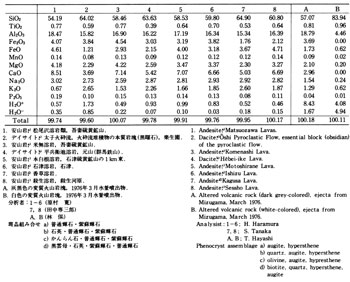Kusatsu-Shirane Volcano
Introduction / Geology of Kusatsu-Shirane Volcano and environs / Geology of Kusatsu-Shirane Volcano
Eruptions of historical times
Rocks of Kusatsu-Shirane Volcano
Geochemistry of Kusatsu-Shirane Volcano
Compositions of volcanic gasses and their variation
Prediction of eruption, mitigation of hazard,
and benefit of volcano
Acknowledgment / References / Postscript
![]() PREV
PREV ![]() NEXT
NEXT
Rocks of Kusatsu-Shirane Volcano
Most rocks constituting Kusatsu-Shirane Volcano are pyroxene andesite family, a commonest rock type in Japan, and pyroxene dacite. The rocks, andesite and dacite, belong to a single continuous series and the different names are just because of definition: the rocks with lower SiO2 contents ( below about 62 % ) is defined as andesite whereas those with higher SiO2 dacite, and the rocks in Kusatsu-Shirane have compositions straddling this boundary ( from SiO2 54 % to 65 % ) ( cf. explanation of terms ). Representative chemical compositions of each eruptive stage are shown in Table 1. Among those, Middle stage lavas except Shirane Lava, part of Kagusa Lava in Younger stage, and those of pyroclastic flows ( Oshi and Yazawahara ) tend to be rich in SiO2 ( 58 to 64 % ) while other rocks are slightly poor ( 54 to 59 % ). All the rocks have abundant phenocrysts with 1 to 2 mm white and transparent plagioclase and black pyroxenes of two varieties embedded in variously colored ( dark black Sessho Lava to grayish white Aoba Lava ) groundmass. The scattered phenocrysts are clearly visible with unaided eyes.
Phenocrysts include plagioclase, hypersthene, augite, and titanomagnetite in all types of rocks besides quartz and olivine in some rocks. Rarely hornblende occurs in addition. Kagusa Lava of Younger stage has biotite as phenocrysts in small amount, but it is always surrounded with corona texture consisting of plagioclase, hypersthene, augite, and titanomagnetite.
The groundmass of low SiO2 rocks ( less than 60 % ) consists of fine-grained plagioclase, pyroxene, silica minerals and infilling brown glass. In high SiO2 rocks ( over 60 % ), groundmass is glassy in general, and consists of colorless glass with little amount of acicular plagioclase and fine-grained pyroxene. In some rocks, spherulite, a devitrification product of aggregate of fine-grained acicular crystals, is formed in the groundmass. In Aoba Lava and Heibei-ike Lava of Middle stage and Kagusa Lava of Younger stage lithologic variation is conspicuous. Within a single lava andesitic part ( dark brown ) and dacitic part ( grayish white ) occur together and in some cases both are intercalated forming alternating layers of 10 to 30 cm thick. Under the microscope, complex mixing of the two are sometimes observed and combination of phenocrysts may be different between andesitic and dacitic parts. Those are formed due to mixing of two different magmas.
